Sipei Zhao
A circular microphone array with virtual microphones based on acoustics-informed neural networks
Feb 24, 2024
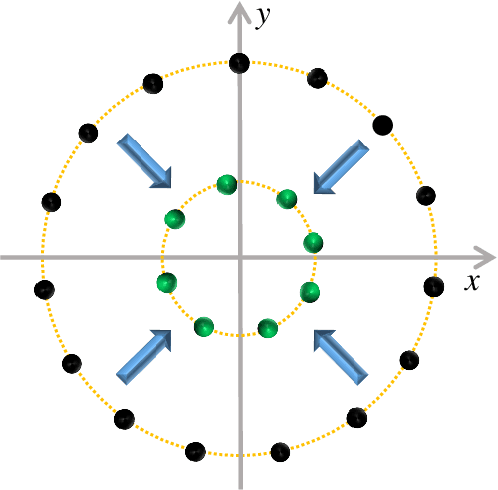
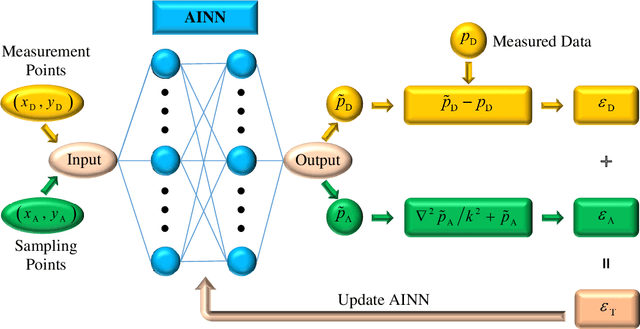
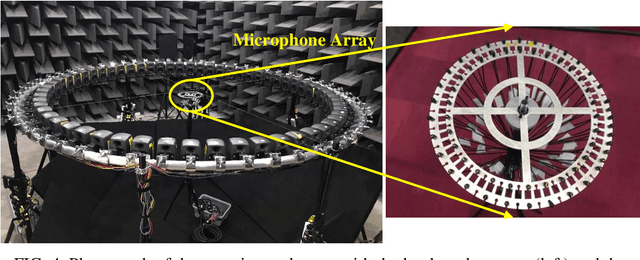
Abstract:Acoustic beamforming aims to focus acoustic signals to a specific direction and suppress undesirable interferences from other directions. Despite its flexibility and steerability, beamforming with circular microphone arrays suffers from significant performance degradation at frequencies corresponding to zeros of the Bessel functions. To conquer this constraint, baffled or concentric circular microphone arrays have been studied; however, the former needs a bulky baffle that interferes with the original sound field whereas the latter requires more microphones that increase the complexity and cost, both of which are undesirable in practical applications. To tackle this challenge, this paper proposes a circular microphone array equipped with virtual microphones, which resolves the performance degradation commonly associated with circular microphone arrays without resorting to physical modifications. The sound pressures at the virtual microphones are predicted from those measured by the physical microphones based on an acoustics-informed neural network, and then the sound pressures measured by the physical microphones and those predicted at the virtual microphones are integrated to design the beamformer. Experimental results demonstrate that the proposed approach not only eliminates the performance degradation but also suppresses spatial aliasing at high frequencies, thereby underscoring its promising potential.
Sound Field Reconstruction Using a Compact Acoustics-informed Neural Network
Feb 14, 2024Abstract:Sound field reconstruction (SFR) augments the information of a sound field captured by a microphone array. Conventional SFR methods using basis function decomposition are straightforward and computationally efficient, but may require more microphones than needed to measure the sound field. Recent studies show that pure data-driven and learning-based methods are promising in some SFR tasks, but they are usually computationally heavy and may fail to reconstruct a physically valid sound field. This paper proposes a compact acoustics-informed neural network (AINN) method for SFR, whereby the Helmholtz equation is exploited to regularize the neural network. As opposed to pure data-driven approaches that solely rely on measured sound pressures, the integration of the Helmholtz equation improves robustness of the neural network against variations during the measurement processes and prompts the generation of physically valid reconstructions. The AINN is designed to be compact, and is able to predict not only the sound pressures but also sound pressure gradients within a spatial region of interest based on measured sound pressures along the boundary. Numerical experiments with acoustic transfer functions measured in different environments demonstrate the superiority of the AINN method over the traditional cylinder harmonic decomposition and the singular value decomposition methods.
A Distributed Algorithm for Personal Sound Zones Systems
Nov 21, 2023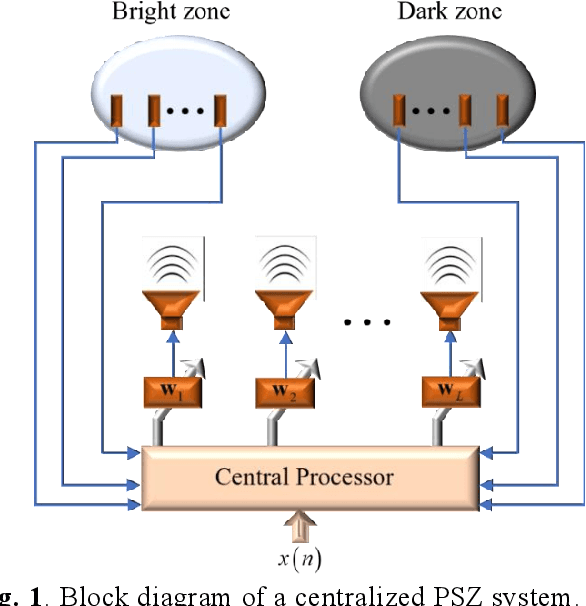
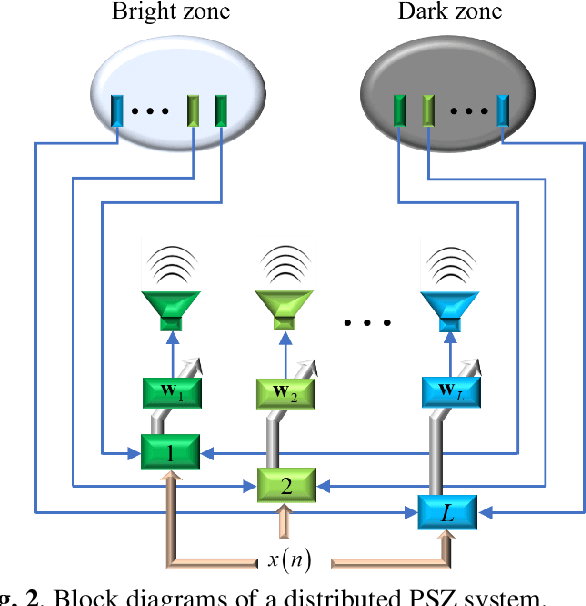
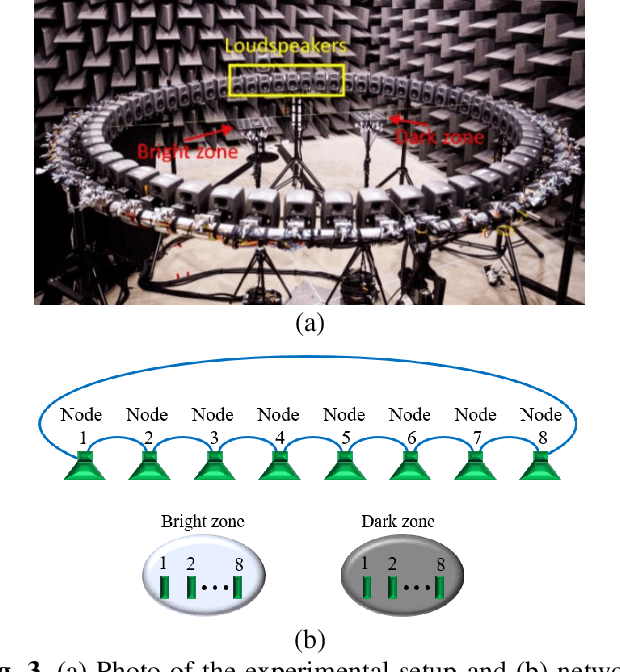
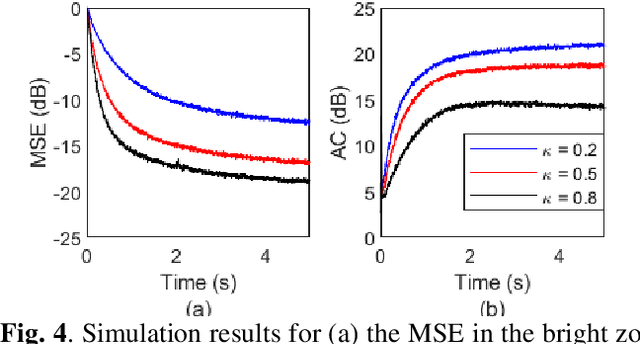
Abstract:A Personal Sound Zones (PSZ) system aims to generate two or more independent listening zones that allow multiple users to listen to different music/audio content in a shared space without the need for wearing headphones. Most existing studies assume that the acoustic paths between loudspeakers and microphones are measured beforehand in a stationary environment. Recently, adaptive PSZ systems have been explored to adapt the system in a time-varying acoustic environment. However, because a PSZ system usually requires multiple loudspeakers, the multichannel adaptive algorithms impose a high computational load on the processor. To overcome that problem, this paper proposes an efficient distributed algorithm for PSZ systems, which not only spreads the computational burden over multiple nodes but also reduces the overall computational complexity, at the expense of a slight decrease in performance. Simulation results with true room impulse responses measured in a Hemi-Anechoic chamber are performed to verify the proposed distributed PSZ system.
Distributed Active Noise Control System Based on a Block Diffusion FxLMS Algorithm with Bidirectional Communication
Dec 28, 2022Abstract:Recently, distributed active noise control systems based on diffusion adaptation have attracted significant research interest due to their balance between computational complexity and stability compared to conventional centralized and decentralized adaptation schemes. However, the existing diffusion FxLMS algorithm employs node-specific adaptation and neighborhood-wide combination, and assumes that the control filters of neighbor nodes are similar to each other. This assumption is not true in practical applications, and it leads to inferior performance to the centralized controller approach. In contrast, this paper proposes a Block Diffusion FxLMS algorithm with bidirectional communication, which uses neighborhood-wide adaptation and node-specific combination to update the control filters. Simulation results validate that the proposed algorithm converges to the solution of the centralized controller with reduced computational burden.
 Add to Chrome
Add to Chrome Add to Firefox
Add to Firefox Add to Edge
Add to Edge